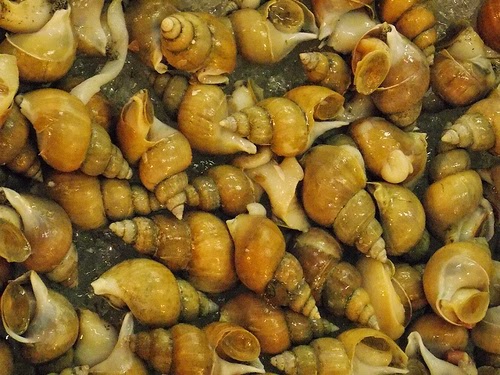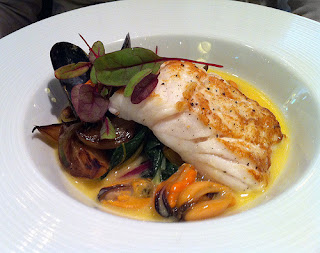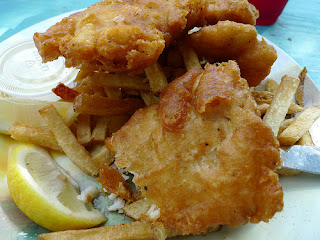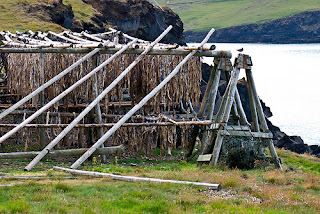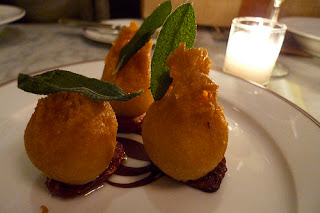from
Behind the French Menu
by
Bryan G. Newman
behindthefrenchmenu@gmail.com
The common whelk.
Photograph courtesy Akuppa John Wigham
Bulot or Bourget or Buccin – A whelk; a tasty sea snail. If you enjoy bigorneau, winkles; coques, cockles; conuque, conch; or palourdes, clams, then whelks should not seem strange. They are all a part of the same family, and their taste and texture are very similar.
Whelks, and sometimes winkles, a British favorite, are an important part of most French seafood platters. In France, whelks may be inside the ravioli or part of a salad or another dish.
Fifty years ago British seaside holidays on the Atlantic coast were never without a cup of winkles and whelks to eat on the spot; a few places continue that tradition. The winkles and whelks in the UK were eaten cold with salt, pepper, and vinegar. They would have been previously boiled in water with vinegar, usually malt vinegar. The best way to eat them was cold with more vinegar while accompanied by bread and butter.
Cooked bulots, whelks, in a French market.
Take them home, make some fresh mayonnaise, and then serve them with French fries or add to another seafood dish.
Photograph courtesy Susan (NYC),
In London, a Jewish immigrant Joseph Malin, a descendant of a Marano family expelled from Portugal in 1496, opened a shop in London’s east end. He was selling the Marono specialty of fried fish to which he added a Belgian import, French fries, chips. Success was instantaneous, and soon there were tens of shops and then tens of thousands of shops selling fish and chips. In short order added to the menu were winkles, whelks, cockles, mussels, shrimp, jellied and smoked eels and more. Then this was good and inexpensive food for the poor and lower classes. These were not just sold from shops, but from wheeled barrows that visited the pubs. From that came the UK tradition of selling seafood by the pint. In the pubs and on the barrows there were no scales, so a pint glass was the standard. Until twenty years ago many fishmongers still offered to sell shrimps and seafood in pints if they were asked. N.B.: Fried fish as a Jewish specialty was recognized already in a book written in 1774 by Hannah Glasse, “The Art of Cookery Made Plain and Easy”. It includes the earliest reference on Jewish recipes for fish: “The Jews’ way of preserving salmon, and all sorts of fish”. I bought the facsimile version of the book that was available for $8.00 from Abes Books.
Whelks may not be as popular today in the UK, but that is now being addressed by many of the best chefs. They are creating new dishes where whelks star. In France, whelks have never been out of fashion and to satisfy its local market 50% of the whelks must be imported. The UK is a very important source of whelks for export to France.
English whelks from Weymouth ready for export to France.
Photograph courtesy of Stephen and Helen Jones
Seafood on sale along the coast in the UK.
Photograph courtesy of Laura Mary
Whelks include a whole family of cousins that will be on menus in North America, Japan and elsewhere. In Japan, whelks will be served as sashimi and sushi.
Whelks on the French menu:
Whelks served with fresh mayonnaise. These are generally served with a plate of French fries, chips and fresh mayonnaise on the side. If the fries and mayonnaise are not included, then order them separately to make this dish perfect. Accompany this dish with a dry (brut) sparkling crémant wine, or in Normandy and Brittany accompany the dish with a dry sparkling cider.
Assiette de Bulots et Crevettes - A plate of whelks and shrimps with fresh mayonnaise.
Bulots Mayonnaise- Whelks served with fresh mayonnaise.
Photograph courtesy of Sébastien Barré
Bulots à l'Aïoli – Whelks served with Provence's famous garlicky mayonnaise.
Toasted ravioli stuffed with whelks and served with a sweet and spicy sauce.
Photograph courtesy of jayne vidheecharoen
Plateau de Fruits de Mer (crevettes rouge, bulots, moules, huîtres). A serving plate with seafood. In this case the Northern pink shrimp, whelks, mussels and oysters. In France plateaus de fruits de mer can be amazing creations. Some come with two or three stories overflowing with the wonders of the sea.
Le Plateau de Fruits de Mer
(crevettes rouge, bulots, huîtres).
A plate of fresh seafood, Northern pink shrimp. whelks, oysters.
Photograph courtesy HS Seidelin,
Salade de Bulots Ravigote – A salad made with whelks and served with a sauce ravigote. Ravigote is a thick vinaigrette/mayonnaise sauce made with mustard, eggs, olive oil and herbs. The sauce is a favorite with fish and shellfish, poultry and veal tongue.
Cassolette de Fruits de Mer, Coquillages, and Buccins de Normandie - A cassolette is a small cooking bowl. French menus often include the name of the bowl or pan used in the preparation of a dish. Here shellfish and whelks from Normandy have been cooked together. Coquillages is one of the French words for seafood.
Salade d'Escargots de Mer « buccin » - A salad of sea-snails, whelks.
Spicy shrimp and whelk stew.
Photograph courtesy of su-lin.
Whelks, in France, are very popular, so much so that France only manages to supply 50% from her own resources. France imports over 20% of the whelks they consume from the UK, the others come from other sources.
Whelks ready for the pots.
Photograph courtesy of P.Gikaa
The pinkish meat of the whelk tends to be chewier than that of smaller whelks. So it is often prepared in a recipe that calls for conch; for example salads, and chowders.
Whelks in the languages of France’s neighbors:
Connected Posts:
Shrimps and Prawns Among the Many Tasty Crustaceans on Your French Menu.
Behind the French Menu’s links include hundreds of words, names, and phrases that are seen on French menus. There are over 400 articles that include over 2,500 French dishes with English translations and explanations. Just add the word, words or phrase that you are searching for to the words "Behind the French Menu" and search with Google.
Behind the French Menu
by
Bryan G. Newman
behindthefrenchmenu@gmail.com
Copyright 2010, 2015, 2017.

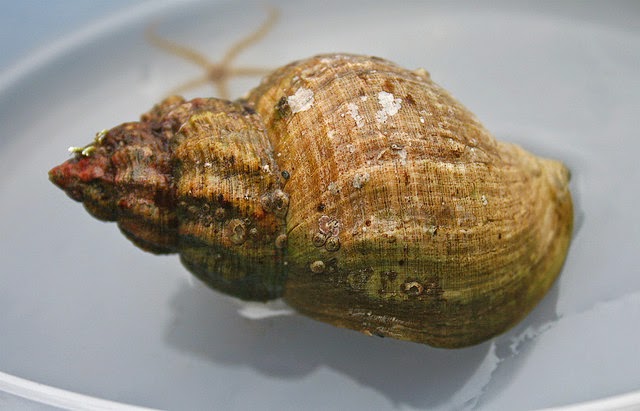
%2C%2B679621521_b6993afed5.jpg)






